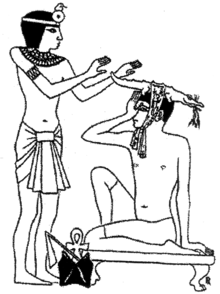User:Adav0303/History of science in early cultures
The history of science in early cultures covers protoscience in the ancient history to Islamic science[1]. In ancient times, culture and knowledge were passed on generation to generation by means of oral tradition. The practice of calligraphy further enabled the ability to preserve knowledge and culture. This allowed communication to travel across generations with greater fidelity. Science has further developed with the assistance of books. During the early era of astronomy, images in textbooks scripted by ancient scholars were meant to develop a complex understanding about structure of the cosmos[2].
Mesopotamia[edit][edit]
Further information: Babylonian astronomy, Babylonian mathematics, and Babylonian medicine
See also: Baghdad Battery Mesopotamian clay tablet-letter from 2400 BC, Louvre. (from King of Lagash, found at Girsu)
During 3500 BC, Sumer (now Iraq), the Mesopotamian people began preserving some observations of the cosmos with extremely thorough numerical data. An evidence of ancient writing forms has been demonstrated by the Pythagoras' law. It was recorded in the 18th century BC, using the Mesopotamian cuneiform tablet known as Plimpton 322. The columns of numbers in the tablet generates several Pythagorean triples (3,4,5) (5,12,13)[3].
Astronomy is a science that lends itself to the recording and study of observations. Scribes recorded observations of the cosmos such as motions of the stars, planets, and the moon on clay tablets. The cuneiform style of writing revealed that astronomers used mathematical calculations to make observations of motions of the planets[4]. Even today, astronomical periods identified by Mesopotamian scientists are still widely used in Western calendars: the solar year, the lunar month, and the seven-day week

| This is the sandbox page where you will draft your initial Wikipedia contribution.
If you're starting a new article, you can develop it here until it's ready to go live. If you're working on improvements to an existing article, copy only one section at a time of the article to this sandbox to work on, and be sure to use an edit summary linking to the article you copied from. Do not copy over the entire article. You can find additional instructions here. Remember to save your work regularly using the "Publish page" button. (It just means 'save'; it will still be in the sandbox.) You can add bold formatting to your additions to differentiate them from existing content. |

Article Draft[edit]
Lead[edit]
Article body[edit]
References[edit]
- ^ "Science in the medieval Islamic world", Wikipedia, 2023-04-04, retrieved 2023-04-29
- ^ Crowther, Kathleen M.; Barker, Peter (2013-09). "Training the Intelligent Eye: Understanding Illustrations in Early Modern Astronomy Texts". Isis. 104 (3): 429–470. doi:10.1086/673269. ISSN 0021-1753.
{{cite journal}}: Check date values in:|date=(help) - ^ "Mathematics". Science News. 159 (4): 56. 2001-01-27. doi:10.2307/3981737.
- ^ "THE WORLD'S OLDEST WRITING". Archaeology. 69 (3): 26–33. 2016. ISSN 0003-8113.
